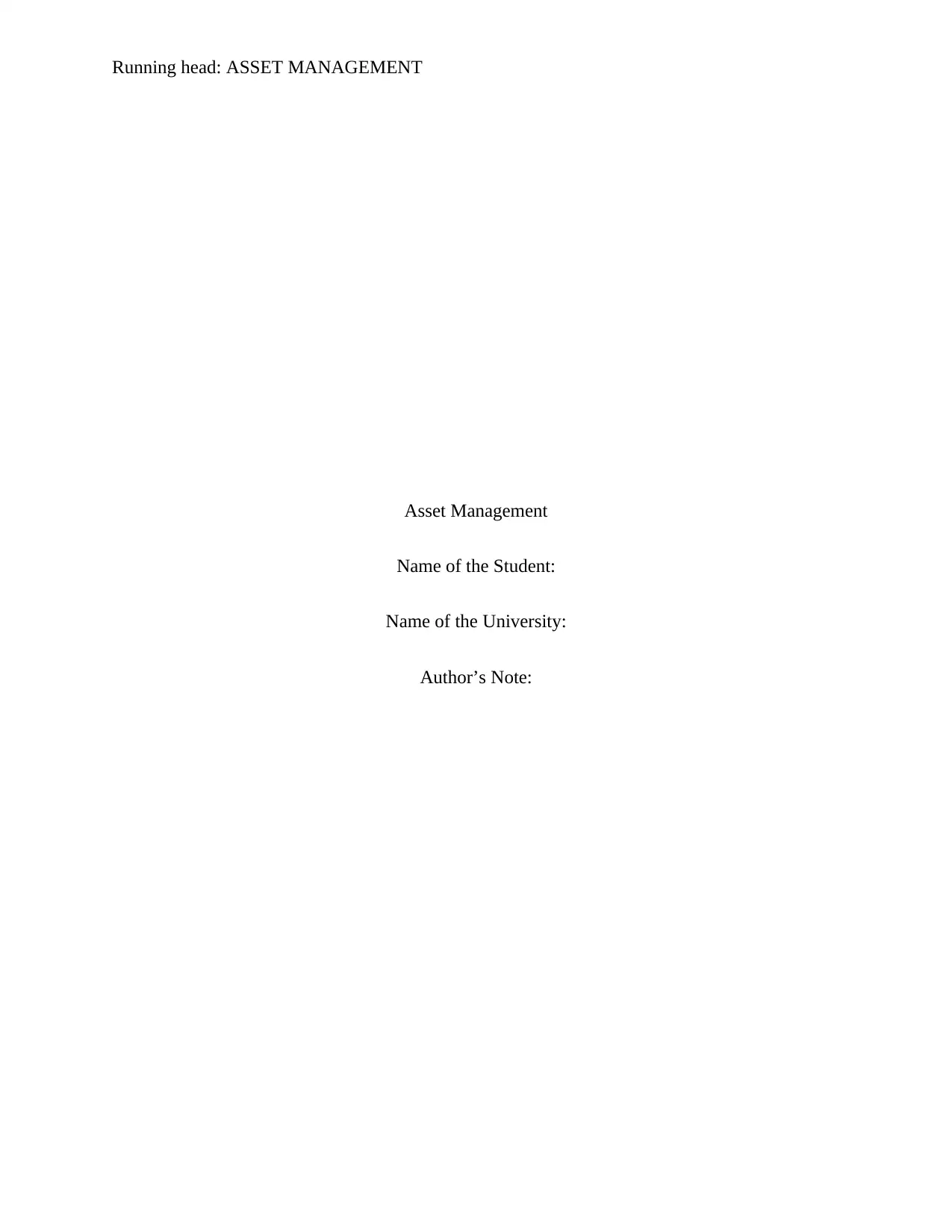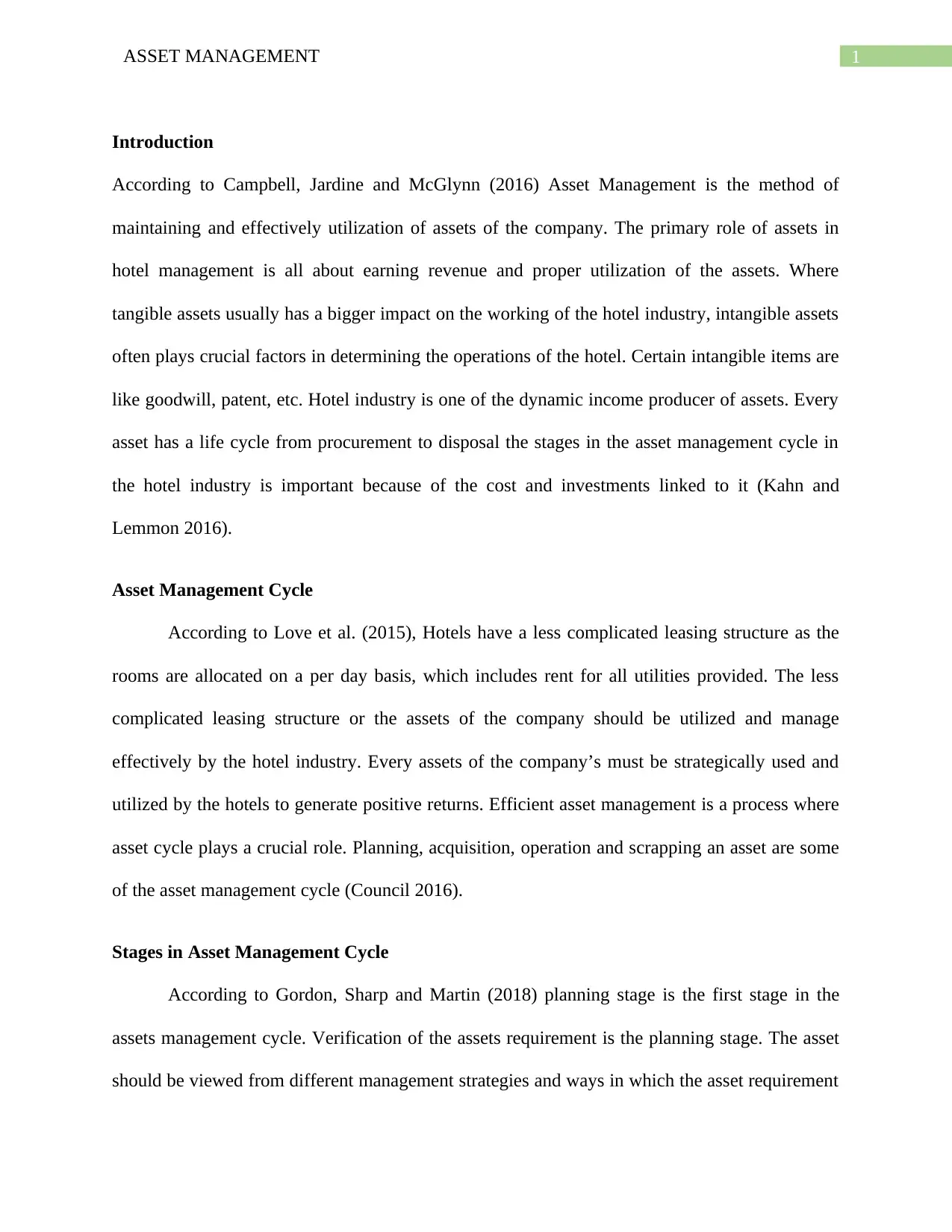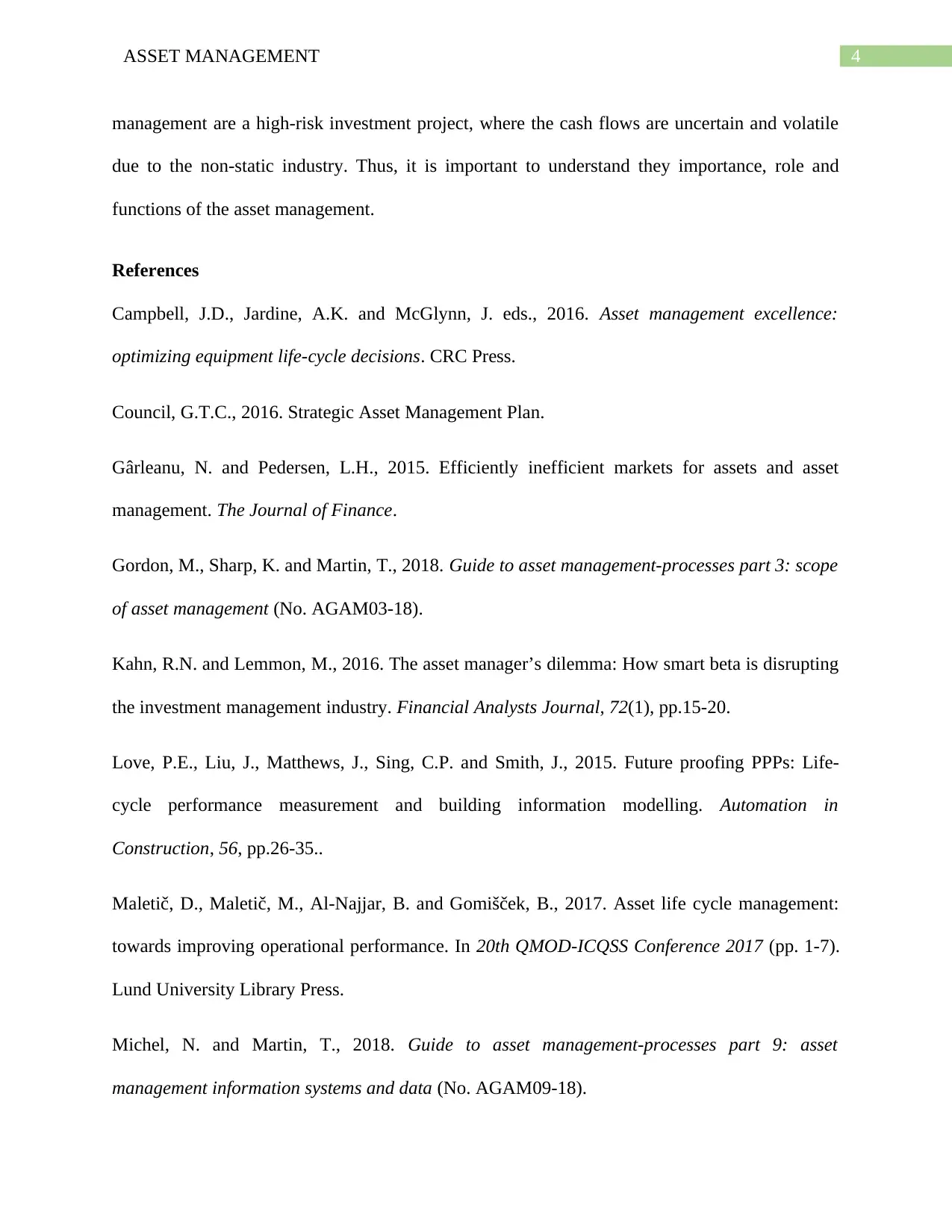Strategic Asset Management for Optimizing Hotel Industry Performance
VerifiedAdded on 2023/06/07
|6
|1360
|435
Essay
AI Summary
This essay explores asset management within the hotel industry, focusing on the asset management cycle, which includes planning, acquisition, operation, and disposal. It emphasizes the importance of strategically utilizing assets to generate revenue and maintain competitiveness. The essay discusses various asset management strategies, such as property management, shifting from cost control to revenue generation, and optimizing asset utilization and financing. It highlights that hotels require continuous oversight and active management due to the volatile nature of the hospitality sector, emphasizing the need to understand the role and functions of asset management to mitigate risks and enhance performance. The document is available on Desklib, a platform offering a range of study tools for students, including past papers and solved assignments.

Running head: ASSET MANAGEMENT
Asset Management
Name of the Student:
Name of the University:
Author’s Note:
Asset Management
Name of the Student:
Name of the University:
Author’s Note:
Paraphrase This Document
Need a fresh take? Get an instant paraphrase of this document with our AI Paraphraser

1ASSET MANAGEMENT
Introduction
According to Campbell, Jardine and McGlynn (2016) Asset Management is the method of
maintaining and effectively utilization of assets of the company. The primary role of assets in
hotel management is all about earning revenue and proper utilization of the assets. Where
tangible assets usually has a bigger impact on the working of the hotel industry, intangible assets
often plays crucial factors in determining the operations of the hotel. Certain intangible items are
like goodwill, patent, etc. Hotel industry is one of the dynamic income producer of assets. Every
asset has a life cycle from procurement to disposal the stages in the asset management cycle in
the hotel industry is important because of the cost and investments linked to it (Kahn and
Lemmon 2016).
Asset Management Cycle
According to Love et al. (2015), Hotels have a less complicated leasing structure as the
rooms are allocated on a per day basis, which includes rent for all utilities provided. The less
complicated leasing structure or the assets of the company should be utilized and manage
effectively by the hotel industry. Every assets of the company’s must be strategically used and
utilized by the hotels to generate positive returns. Efficient asset management is a process where
asset cycle plays a crucial role. Planning, acquisition, operation and scrapping an asset are some
of the asset management cycle (Council 2016).
Stages in Asset Management Cycle
According to Gordon, Sharp and Martin (2018) planning stage is the first stage in the
assets management cycle. Verification of the assets requirement is the planning stage. The asset
should be viewed from different management strategies and ways in which the asset requirement
Introduction
According to Campbell, Jardine and McGlynn (2016) Asset Management is the method of
maintaining and effectively utilization of assets of the company. The primary role of assets in
hotel management is all about earning revenue and proper utilization of the assets. Where
tangible assets usually has a bigger impact on the working of the hotel industry, intangible assets
often plays crucial factors in determining the operations of the hotel. Certain intangible items are
like goodwill, patent, etc. Hotel industry is one of the dynamic income producer of assets. Every
asset has a life cycle from procurement to disposal the stages in the asset management cycle in
the hotel industry is important because of the cost and investments linked to it (Kahn and
Lemmon 2016).
Asset Management Cycle
According to Love et al. (2015), Hotels have a less complicated leasing structure as the
rooms are allocated on a per day basis, which includes rent for all utilities provided. The less
complicated leasing structure or the assets of the company should be utilized and manage
effectively by the hotel industry. Every assets of the company’s must be strategically used and
utilized by the hotels to generate positive returns. Efficient asset management is a process where
asset cycle plays a crucial role. Planning, acquisition, operation and scrapping an asset are some
of the asset management cycle (Council 2016).
Stages in Asset Management Cycle
According to Gordon, Sharp and Martin (2018) planning stage is the first stage in the
assets management cycle. Verification of the assets requirement is the planning stage. The asset
should be viewed from different management strategies and ways in which the asset requirement

2ASSET MANAGEMENT
can meet the daily-required services of the hotel industry. The hotel industry should carry
effective planning in the asset management cycle, as it will allow recognizing key assets and
underperforming assets of the hotels, availability of resources, maintenance of assets and
provisioning of assets. The second stage of the cycle comes the acquisition of the asset, which is
the further expansion of planning. The hotel should prepare budgetary analysis for the same the
cost to benefit analysis they will provide. The operations of the hotel industry is a key factor
assets should be able to render services which in turn will generate revenue for the hotel. The
operation and maintenance of the assets comes as the third stage of the asset management cycle.
Every asset of the hotel should be able to produce service or benefit it via directly or indirectly. It
is necessary to check the efficient and optimum utilization of these assets in the industry. Finally,
if the assets usage are for a prolonged period or has completed the lifecycle there comes the final
stage of the asset management cycle the disposal stage. Proper reallocation and replacement of
assets in the right place and at the right time will help the hotel industry compete better in terms
of service and products it caters (Michel and Martin 2018).
Asset Management Strategies
According to Gârleanu and Pedersen, (2015) Asset management strategies is applied in
order to enhance the efficiency in the operations of the company. Property management deals
with the critical assessment of public areas, food and beverages sections and the guest rooms.
Every asset of the hotel should be carefully analyzed whether the asset is able to render services
and deliver better output. Certain changes must be done periodically to include and align with
changing taste and preferences of the people like the food and beverages section and the guest
room. Hotel should move there focus from cost controlling techniques to revenue generation
strategies. Hotel should focus less on cutting there operational costs as these can hamper the
can meet the daily-required services of the hotel industry. The hotel industry should carry
effective planning in the asset management cycle, as it will allow recognizing key assets and
underperforming assets of the hotels, availability of resources, maintenance of assets and
provisioning of assets. The second stage of the cycle comes the acquisition of the asset, which is
the further expansion of planning. The hotel should prepare budgetary analysis for the same the
cost to benefit analysis they will provide. The operations of the hotel industry is a key factor
assets should be able to render services which in turn will generate revenue for the hotel. The
operation and maintenance of the assets comes as the third stage of the asset management cycle.
Every asset of the hotel should be able to produce service or benefit it via directly or indirectly. It
is necessary to check the efficient and optimum utilization of these assets in the industry. Finally,
if the assets usage are for a prolonged period or has completed the lifecycle there comes the final
stage of the asset management cycle the disposal stage. Proper reallocation and replacement of
assets in the right place and at the right time will help the hotel industry compete better in terms
of service and products it caters (Michel and Martin 2018).
Asset Management Strategies
According to Gârleanu and Pedersen, (2015) Asset management strategies is applied in
order to enhance the efficiency in the operations of the company. Property management deals
with the critical assessment of public areas, food and beverages sections and the guest rooms.
Every asset of the hotel should be carefully analyzed whether the asset is able to render services
and deliver better output. Certain changes must be done periodically to include and align with
changing taste and preferences of the people like the food and beverages section and the guest
room. Hotel should move there focus from cost controlling techniques to revenue generation
strategies. Hotel should focus less on cutting there operational costs as these can hamper the
⊘ This is a preview!⊘
Do you want full access?
Subscribe today to unlock all pages.

Trusted by 1+ million students worldwide

3ASSET MANAGEMENT
services of the hotel rather the hotel should focus on driving more volume and occupancy rates in
the hotel. Market share of a hotel plays an important role in the hotel industry it shows the
perception of the consumers about the products or services offered to them. Hotel usually having
high market share shows that the assets of the hotel are used and managed efficiently and
actively. Asset managers tend to focus much on these factors as it comes as the outcome of all
strategies deployed. Cost management and profit management are some of the primary roles
while evaluating the contribution of the assets. Asset utilization and asset financing are some of
the key role the asset should play. Asset utilization understands assets capability in terms of the
output of assets. Asset utilization in hotel industry differs from those traditional financial
approach where the banquet rooms should not be always looked at the per square feet of revenue
generated rather it should be looked as the occupancy and the extra revenue it provides from
other hotel services like the food and beverages section, organizing and conducting different
events. The other key aspect in the asset management is about the financing of these assets in the
hotel industry. The hotel industry operates in the hospitality sector where the business risk is
quite high. It should not always opt for debt financing of assets if debt forms a major part of its
liabilities and when the majority of the assets is financed through debt. Generally, the company
should go for debt financing of its assets if the company is in high tax bracket. Stable operations
and minimum exposure to debt significantly less than the industry average is good for a company
(Maletič, et al. 2017).
Conclusion
Hotel are special type of asset class, which requires continuous oversight and active
management. The hotel industry should identify the key aspects of the asset management and the
strategies, which they can apply for efficient and active utilization of assets. Hotel assets
services of the hotel rather the hotel should focus on driving more volume and occupancy rates in
the hotel. Market share of a hotel plays an important role in the hotel industry it shows the
perception of the consumers about the products or services offered to them. Hotel usually having
high market share shows that the assets of the hotel are used and managed efficiently and
actively. Asset managers tend to focus much on these factors as it comes as the outcome of all
strategies deployed. Cost management and profit management are some of the primary roles
while evaluating the contribution of the assets. Asset utilization and asset financing are some of
the key role the asset should play. Asset utilization understands assets capability in terms of the
output of assets. Asset utilization in hotel industry differs from those traditional financial
approach where the banquet rooms should not be always looked at the per square feet of revenue
generated rather it should be looked as the occupancy and the extra revenue it provides from
other hotel services like the food and beverages section, organizing and conducting different
events. The other key aspect in the asset management is about the financing of these assets in the
hotel industry. The hotel industry operates in the hospitality sector where the business risk is
quite high. It should not always opt for debt financing of assets if debt forms a major part of its
liabilities and when the majority of the assets is financed through debt. Generally, the company
should go for debt financing of its assets if the company is in high tax bracket. Stable operations
and minimum exposure to debt significantly less than the industry average is good for a company
(Maletič, et al. 2017).
Conclusion
Hotel are special type of asset class, which requires continuous oversight and active
management. The hotel industry should identify the key aspects of the asset management and the
strategies, which they can apply for efficient and active utilization of assets. Hotel assets
Paraphrase This Document
Need a fresh take? Get an instant paraphrase of this document with our AI Paraphraser

4ASSET MANAGEMENT
management are a high-risk investment project, where the cash flows are uncertain and volatile
due to the non-static industry. Thus, it is important to understand they importance, role and
functions of the asset management.
References
Campbell, J.D., Jardine, A.K. and McGlynn, J. eds., 2016. Asset management excellence:
optimizing equipment life-cycle decisions. CRC Press.
Council, G.T.C., 2016. Strategic Asset Management Plan.
Gârleanu, N. and Pedersen, L.H., 2015. Efficiently inefficient markets for assets and asset
management. The Journal of Finance.
Gordon, M., Sharp, K. and Martin, T., 2018. Guide to asset management-processes part 3: scope
of asset management (No. AGAM03-18).
Kahn, R.N. and Lemmon, M., 2016. The asset manager’s dilemma: How smart beta is disrupting
the investment management industry. Financial Analysts Journal, 72(1), pp.15-20.
Love, P.E., Liu, J., Matthews, J., Sing, C.P. and Smith, J., 2015. Future proofing PPPs: Life-
cycle performance measurement and building information modelling. Automation in
Construction, 56, pp.26-35..
Maletič, D., Maletič, M., Al-Najjar, B. and Gomišček, B., 2017. Asset life cycle management:
towards improving operational performance. In 20th QMOD-ICQSS Conference 2017 (pp. 1-7).
Lund University Library Press.
Michel, N. and Martin, T., 2018. Guide to asset management-processes part 9: asset
management information systems and data (No. AGAM09-18).
management are a high-risk investment project, where the cash flows are uncertain and volatile
due to the non-static industry. Thus, it is important to understand they importance, role and
functions of the asset management.
References
Campbell, J.D., Jardine, A.K. and McGlynn, J. eds., 2016. Asset management excellence:
optimizing equipment life-cycle decisions. CRC Press.
Council, G.T.C., 2016. Strategic Asset Management Plan.
Gârleanu, N. and Pedersen, L.H., 2015. Efficiently inefficient markets for assets and asset
management. The Journal of Finance.
Gordon, M., Sharp, K. and Martin, T., 2018. Guide to asset management-processes part 3: scope
of asset management (No. AGAM03-18).
Kahn, R.N. and Lemmon, M., 2016. The asset manager’s dilemma: How smart beta is disrupting
the investment management industry. Financial Analysts Journal, 72(1), pp.15-20.
Love, P.E., Liu, J., Matthews, J., Sing, C.P. and Smith, J., 2015. Future proofing PPPs: Life-
cycle performance measurement and building information modelling. Automation in
Construction, 56, pp.26-35..
Maletič, D., Maletič, M., Al-Najjar, B. and Gomišček, B., 2017. Asset life cycle management:
towards improving operational performance. In 20th QMOD-ICQSS Conference 2017 (pp. 1-7).
Lund University Library Press.
Michel, N. and Martin, T., 2018. Guide to asset management-processes part 9: asset
management information systems and data (No. AGAM09-18).

5ASSET MANAGEMENT
⊘ This is a preview!⊘
Do you want full access?
Subscribe today to unlock all pages.

Trusted by 1+ million students worldwide
1 out of 6
Related Documents
Your All-in-One AI-Powered Toolkit for Academic Success.
+13062052269
info@desklib.com
Available 24*7 on WhatsApp / Email
![[object Object]](/_next/static/media/star-bottom.7253800d.svg)
Unlock your academic potential
Copyright © 2020–2025 A2Z Services. All Rights Reserved. Developed and managed by ZUCOL.





